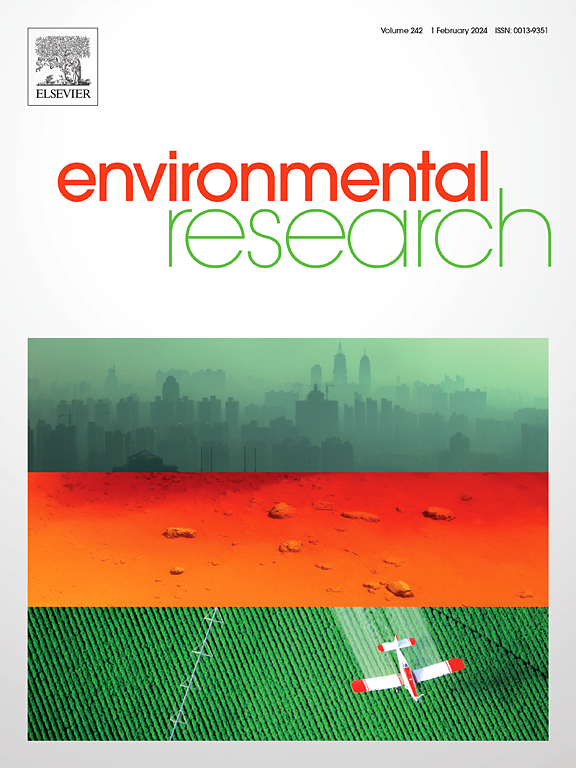大型富营养化河口有机碳组成及生化活性的分级分析。
IF 7.7
2区 环境科学与生态学
Q1 ENVIRONMENTAL SCIENCES
引用次数: 0
摘要
难降解溶解有机碳(RDOC)的存在会导致对有机污染的错误估计,而关于有机碳(OC)的特征及其与污染关系的文献很少。本研究采用物理分离、生物培养和化学分析等方法,对中国污染最严重的河口之一长江口水体中有机碳的大小分馏组成和生物利用度进行了研究。结果表明,有机碳的化学特征具有高度多样性,RDOC约占溶解有机碳(DOC)的65.8%±9.2%。在培养过程中,超高分辨率质谱法鉴定的CHO分子(仅由碳、氢和氧原子组成的分子)降解率不到10%。粒径分馏OC与RDOC呈显著的正线性关系,表明粒径越小,RDOC的顽固性越强。>.45 μm馏分中存在的OC对不稳定OC(包括与化学需氧量(COD)评估相关的OC颗粒份额)尤为重要。排除RDOC可以更准确地估计不稳定OC对COD的贡献,如公式所示:CODLabile = 0.47×CODBulk - 0.03。每年约有0.44±0.10 Gt的难降解OC,包括0.31±0.07 Gt的RDOC,通过河流输送到海洋中。这种线性关系揭示了目前有机污染评价的高估,忽视了RDOC在碳保存中的作用,因此有必要对河口COD评价方法进行修订。本研究强调了难降解OC和不稳定OC对大型富营养化河口OC污染量化的不同影响。本文章由计算机程序翻译,如有差异,请以英文原文为准。
Constraining the composition and biochemical activity of organic carbon in a large eutrophic estuary using size-fractionated analysis
The presence of refractory dissolved organic carbon (RDOC) can result in the misestimation of organic pollution, and documentation regarding the characteristics of organic carbon (OC) and its relationship with pollution is limited. This study employed physical separation, biological incubation, and chemical analysis to examine the size-fractionated composition and bioavailability of OC in the Yangtze River Estuary, one of the most polluted estuarine areas in China. Results revealed that OC chemical features were highly diverse, with RDOC constituting approximately 65.8% ± 9.2% of dissolved organic carbon (DOC). During incubation, less than 10% of CHO molecules (molecules composed solely of carbon, hydrogen and oxygen atoms) identified by ultra-high resolution mass spectrometry were degraded. A significant positive linear relationship between OC and RDOC in size-fractionated OC indicated greater recalcitrance in smaller size fractions. The OC present in the >0.45 μm fraction was notably important for labile OC, including the particulate fraction of OC, which is relevant to chemical oxygen demand (COD) assessments. Excluding RDOC allows for a more accurate estimation of the contribution of labile OC to COD, as represented by the equation: CODLabile = 0.47 × CODBulk - 0.03. Approximately 0.44 ± 0.10 Gt of refractory OC, including 0.31 ± 0.07 Gt of RDOC, is transported annually into the ocean via rivers. This linear relationship of COD reveals an overestimation in current assessments of organic pollution and a neglect of RDOC's role in carbon preservation, thereby necessitating a revision of the COD evaluation practices in estuaries. This study highlights the differentiated impacts of refractory and labile OC on the quantification of OC pollution in a large eutrophic estuary.
求助全文
通过发布文献求助,成功后即可免费获取论文全文。
去求助
来源期刊

Environmental Research
环境科学-公共卫生、环境卫生与职业卫生
CiteScore
12.60
自引率
8.40%
发文量
2480
审稿时长
4.7 months
期刊介绍:
The Environmental Research journal presents a broad range of interdisciplinary research, focused on addressing worldwide environmental concerns and featuring innovative findings. Our publication strives to explore relevant anthropogenic issues across various environmental sectors, showcasing practical applications in real-life settings.
 求助内容:
求助内容: 应助结果提醒方式:
应助结果提醒方式:


